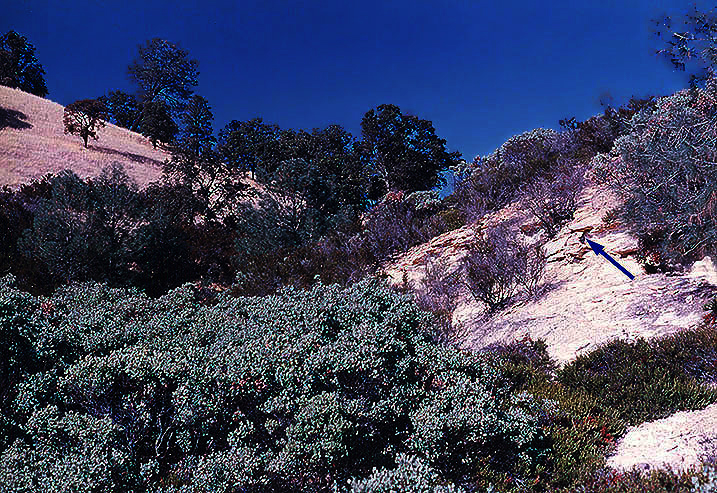
|
Here is a third major fossil leaf discovery in the Middle Eocene Ione Formation, Ione Basin, Amador County, California. The blue arrow at right points to the precise locality of the fossil-bearing horizon--a brownish feldspar-rich sandstone-shale which lies very near the top of the Ione Formation. Note the pale-brown grass-covered slope at upper left, above the olive-green brush (white-leaf manzanita) in middle-ground; rocks underlying that surface belong to the overlying, Miocene Valley Springs Formation. The plants at this particular site are preserved here in both exquisite detail and eye-catching, pleasing abundance. Loads of whole, complete leaves can often be observed covering the bedding planes. It is a locality that should be meticulously quarried by professional paleobotanists, but the problem is that the land ownership here is a complete, utter, irreconcilable mess. Repeated attempts to contact the new owners have failed. Before the ownership fiasco, I was able to collect many beautiful leaf-bearing slabs from this locality, all of which now reside at the University California Museum Of Paleontology in Berkeley. I happened to discover this site on May 4, 1993. Here is a quote from my field notebook on that day: " "5/4/93--1:38pm--Tuesday: Back from hike. Eureka! More fossil plants! The leaves, seeds and Taxodium (?) twigs come from a narrow gray-brownish horizon in the limited exposure. The Ione(?)/Valley Springs exposure is very limited in extent and leaves were recovered only from that foot-thick shale horizon. Beautiful weather. Sunny-warm, a nice breeze. Fantastic Sierran foothill scenery. This newly discovered fossil horizon seems to yield a slightly different flora than the other sites; a smaller-type of leaf is prevalent here, as well as the swamp cypress twigs and needles. I am genuinely revved about this new site, but I realize that to get the best material a major quarrying operation would have to be undertaken--something I am not prepared to do on my own." Note my identification of "swamp cypress" from this specific site. Most likely what I was referring to were fragments of palms. I am still not certain that swamp cypress has been officially identified from the Ione Formation of the Ione Basin. Also interesting to note here is the low patch of dark green shrubbery at the lower right of the image--that is the rare and endangered Ione manzanita, which is endemic to the harsh mineral-rich soils of the Ione Basin: the Ione manzanita grows nowhere else on Earth in the wild. Please note: All fossil localities in the Ione Formation of Amador County, California, presently occur on private property; explicit permission from the land owners must be secured before collecting fossils there. |